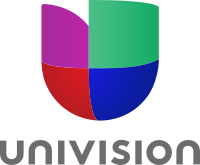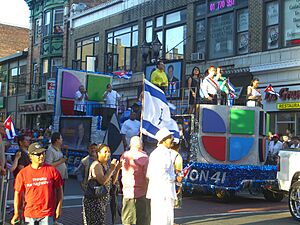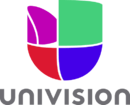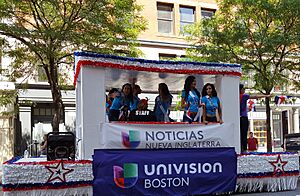Univision facts for kids

Logo used since 2019
|
|
| Type | Free-to-air television network |
|---|---|
| Country | United States |
| Affiliates | See list of affiliates |
| Headquarters | 605 Third Avenue New York City, NY 10158 U.S. |
| Programming | |
| Language(s) | Spanish |
| Picture format | 1080i HDTV 1080p via ATSC 3.0 in some markets (re-scaled to 16:9 480i for some affiliated stations) |
| Timeshift service |
|
| Ownership | |
| Owner | TelevisaUnivision |
| Key people | Daniel Alegre (CEO) |
| Sister channels |
|
| History | |
| Launched | September 29, 1962 |
| Founder | Debateable: Raoul A. Cortez, Emilio Nicolas Sr., Rene Anselmo |
| Former names | Spanish International Network (1962–1987) |
| Availability | |
| Streaming media | |
| YouTube TV | Internet Protocol television |
| Vidgo | Internet Protocol television |
Univision is an American TV network that broadcasts completely in Spanish. It is owned by TelevisaUnivision and is the largest provider of Spanish-language shows in the United States. The network's shows are made for Latino and Hispanic audiences.
Univision's programming includes popular dramas called telenovelas, sports, comedies, reality shows, and news. The main office is in New York City, but its biggest studios are in Doral, Florida, near Miami.
You can watch Univision on cable or satellite TV all over the United States. It also has local stations in more than 60 cities with large Hispanic communities. These local stations show their own news and programs in addition to the national shows from Univision.
Contents
History of Univision
How It All Started
The story of Univision begins in 1955. A man named Raoul A. Cortez started a TV station in San Antonio, Texas, called KCOR-TV. It was the first station in the U.S. to broadcast only in Spanish.
In 1961, the station was sold to a group led by Emilio Azcárraga Vidaurreta, who owned a large media company in Mexico. They invested a lot of money in the station and brought in many popular shows from Mexico. This helped the station become successful.
On September 29, 1962, the owners started a second Spanish-language station in Los Angeles. These two stations in San Antonio and Los Angeles became the start of a new network called the Spanish International Network (SIN). This was the first TV network in the U.S. to broadcast in a language other than English.
Over the next 15 years, SIN added more stations in cities like New York, Miami, and Phoenix. The network grew and became available to more people through cable television.
Becoming Univision
In 1987, the network was sold to a new group of owners. They changed the network's name from SIN to Univision. The new leaders wanted to create more shows in the U.S. that would appeal to Hispanic people from all different countries.
They started a policy to use a neutral type of Spanish that everyone could understand. They also began making their own shows. One of the first was a talk show for women called TV Mujer ("Woman TV").
Univision also signed contracts with famous hosts like Cristina Saralegui and Don Francisco. Cristina's talk show, El Show de Cristina, was on the air for 22 years. Don Francisco's variety show, Sábado Gigante ("Giant Saturday"), was a huge hit and aired for 29 years.
Growth and Competition
In 1992, Univision was sold again. The new owners included American businessman A. Jerrold Perenchio and partners from Mexico's Televisa and Venezuela's Venevision. This deal gave Univision access to many popular telenovelas from both companies.
The network started to produce more of its own news and entertainment shows in the U.S. This helped Univision compete with its main rival, Telemundo. By the late 1990s, Univision was so popular that it sometimes had more viewers than some English-language networks.
In 1998, the network launched the entertainment news show El Gordo y La Flaca ("The Scoop and the Skinny"). It became very successful and is still on the air today.
The 2000s: A New Century
In the 2000s, Univision continued to grow. It bought more TV stations across the country and also purchased a group of Spanish-language radio stations, which became Univision Radio.
In 2005, the network aired a special tribute concert called Selena ¡VIVE! ("Selena Lives!"). It was in honor of the singer Selena, who had passed away ten years earlier. The concert was a huge success and became the most-watched Spanish-language show in American TV history.
By the middle of the decade, Univision was often the fifth most-watched TV network in the U.S., beating other networks like UPN and The WB.
In 2007, Univision was sold to a group of investment companies. The network also hosted the first-ever Spanish-language presidential debate in the U.S. at the University of Miami.
Recent Years
In 2012, Univision updated its logo to look like a multi-colored, 3D heart. This was to show that the company was growing and connecting with Hispanic cultures.
In 2013, Univision partnered with ABC News to create Fusion, an English-language news channel for young Hispanic viewers.
In 2021, Univision and Televisa merged their media and production businesses. This created a new, larger company called TelevisaUnivision. The new company aims to be the biggest Spanish-language media company in the world.
In 2023, Univision co-hosted a Republican presidential primary debate. The network also aired a special interview with former President Donald Trump, which led to a lot of discussion among viewers and the media.
What's on Univision?
Univision shows a wide variety of programs 24 hours a day. Most of its shows are general entertainment. Many of its local stations also produce their own news and public affairs shows.
Telenovelas and Series
The most popular shows on Univision are telenovelas, which are like drama series or soap operas. Most of these are produced by Televisa in Mexico. The network also shows other series, including comedies and reality shows like Nuestra Belleza Latina ("Our Latin Beauty").
One of the network's most famous shows was Sábado Gigante. It was a variety show that aired every Saturday night for almost 30 years, making it one of the longest-running TV shows in history.
News Programs
Univision has a respected news division called Noticias Univision ("Univision News"). Its main news show is Noticiero Univision, which airs every evening.
The network also has a popular morning show called ¡Despierta América! ("Wake Up America!"). It's similar to English-language morning shows like Today and Good Morning America. It features news, weather, interviews, and entertainment.
Another key news show is Primer Impacto ("First Impact"), a newsmagazine that covers interesting stories from around the world.
Sports Coverage
The network's sports division is called TUDN, which stands for Televisa Univision Deportes Network. It shows many popular sporting events, especially soccer.
Univision broadcasts matches from Mexico's top soccer league, Liga MX, as well as games featuring the national teams of Mexico and the United States. It also covers major tournaments like the CONCACAF Gold Cup and Copa América.
Shows for Kids
On Saturday mornings, Univision has a special block of shows for children called Planeta U ("Planet U"). This block features Spanish-language versions of popular American kids' shows.
In the past, Univision has aired many famous children's programs, including the Spanish-language version of Sesame Street, called Plaza Sésamo.
Univision's Other Channels
Univision Communications owns several other TV channels.
- UniMás: This is another broadcast network that shows telenovelas, movies, and sports. It is aimed at a younger audience than Univision.
- Galavisión: This is a cable channel that shows classic comedies, telenovelas, and news programs from Televisa's library.
- TUDN: This is a cable channel completely dedicated to sports, showing soccer games and sports news 24/7.
- Univision tlnovelas: A cable channel that airs classic and new telenovelas from Televisa and Univision.
Where to Watch Univision
Univision has local stations in over 25 states, as well as in Washington, D.C., and Puerto Rico. This means it can be watched for free with an antenna in many parts of the country. It is also available on almost every cable and satellite TV service.
For people who want to watch online, Univision offers streaming services like Univision NOW. This service lets you watch live TV and full episodes of shows on your computer, phone, or tablet.
bat-smg:Univision
See also
 In Spanish: Univision para niños
In Spanish: Univision para niños





